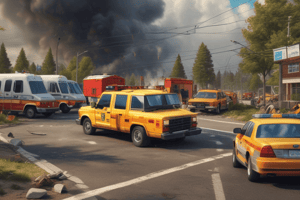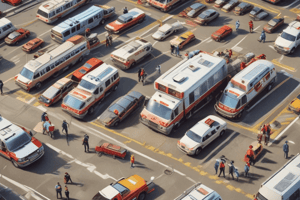Podcast
Questions and Answers
What is the primary purpose of communication?
What is the primary purpose of communication?
- To convey information only
- To convey information, express emotions, build relationships, and coordinate actions (correct)
- To receive messages only
- To transmit information only
What is essential for effective communication?
What is essential for effective communication?
- The interpretation of the message by the sender
- Only the transmission of information
- Only the reception of the message
- Clarity, accuracy, and appropriateness in conveying thoughts and ideas (correct)
What is the role of communication in disaster situations?
What is the role of communication in disaster situations?
- It is only for organizational settings
- It facilitates risk assessment, emergency response, and recovery efforts (correct)
- It is only for personal interactions
- It is not necessary in disaster situations
What is involved in the process of communication?
What is involved in the process of communication?
What type of communication involves verbal and non-verbal forms?
What type of communication involves verbal and non-verbal forms?
In which of the following contexts can communication occur?
In which of the following contexts can communication occur?
What is the outcome of effective communication?
What is the outcome of effective communication?
What is the definition of communication?
What is the definition of communication?
What is the primary purpose of communication in disaster situations?
What is the primary purpose of communication in disaster situations?
When does communication become crucial in disaster situations?
When does communication become crucial in disaster situations?
What is the outcome of effective communication in disaster situations?
What is the outcome of effective communication in disaster situations?
What is the foundation for collecting and disseminating essential information during the risk assessment phase?
What is the foundation for collecting and disseminating essential information during the risk assessment phase?
What is the primary purpose of communication during the risk assessment phase?
What is the primary purpose of communication during the risk assessment phase?
What is the result of establishing clear lines of communication during the risk assessment phase?
What is the result of establishing clear lines of communication during the risk assessment phase?
What is the role of communication in disaster situations?
What is the role of communication in disaster situations?
What is the benefit of effective communication in disaster situations?
What is the benefit of effective communication in disaster situations?
What is the primary purpose of effective communication in disaster response?
What is the primary purpose of effective communication in disaster response?
Who are the stakeholders involved in disaster response?
Who are the stakeholders involved in disaster response?
What is achieved through effective communication in disaster response?
What is achieved through effective communication in disaster response?
What is the role of effective communication in disaster response?
What is the role of effective communication in disaster response?
What is shared through effective communication in disaster response?
What is shared through effective communication in disaster response?
Why is effective communication important in disaster response?
Why is effective communication important in disaster response?
What is the result of effective communication in disaster response?
What is the result of effective communication in disaster response?
What is facilitated through effective communication in disaster response?
What is facilitated through effective communication in disaster response?
What is the UK Government's approach to improving risk communication?
What is the UK Government's approach to improving risk communication?
What is the purpose of the Annual Statement to Parliament on civil contingencies risks?
What is the purpose of the Annual Statement to Parliament on civil contingencies risks?
Why is it important for the government to engage with disproportionately affected populations?
Why is it important for the government to engage with disproportionately affected populations?
What is the benefit of collaborating with national and local partners in risk communication?
What is the benefit of collaborating with national and local partners in risk communication?
What is the ultimate goal of improving risk communication?
What is the ultimate goal of improving risk communication?
What type of information will the government provide to improve risk communication?
What type of information will the government provide to improve risk communication?
What is the role of the Annual Statement to Parliament in increasing transparency on risk?
What is the role of the Annual Statement to Parliament in increasing transparency on risk?
What is the benefit of incorporating lessons learned into future communication plans and strategies?
What is the benefit of incorporating lessons learned into future communication plans and strategies?
What is the purpose of establishing clear protocols for information sharing and coordination?
What is the purpose of establishing clear protocols for information sharing and coordination?
What is the benefit of providing training and education to communication teams and spokespersons?
What is the benefit of providing training and education to communication teams and spokespersons?
How can technology and social media be utilized during a disaster response?
How can technology and social media be utilized during a disaster response?
Why is it important to engage with community leaders and stakeholders?
Why is it important to engage with community leaders and stakeholders?
What is the purpose of conducting a post-event evaluation?
What is the purpose of conducting a post-event evaluation?
What is the benefit of utilizing geolocation tools and mapping?
What is the benefit of utilizing geolocation tools and mapping?
Why is it important to address emotional and psychological needs during a disaster response?
Why is it important to address emotional and psychological needs during a disaster response?
What is the purpose of regular coordination meetings?
What is the purpose of regular coordination meetings?
Flashcards
Disaster Response Communication Protocols
Disaster Response Communication Protocols
Clear rules for sharing information among agencies, governments, and communities during disasters.
Accurate Disaster Info
Accurate Disaster Info
Correct and timely information for all stakeholders to avoid errors.
Coordination Meetings (Disasters)
Coordination Meetings (Disasters)
Regular meetings to share information and work together during a disaster.
Communication Team Training
Communication Team Training
Signup and view all the flashcards
Crisis Communication Skills
Crisis Communication Skills
Signup and view all the flashcards
Media Relations Disaster
Media Relations Disaster
Signup and view all the flashcards
Social Media in Disaster
Social Media in Disaster
Signup and view all the flashcards
Misinformation Monitoring
Misinformation Monitoring
Signup and view all the flashcards
Real-Time Disaster Data
Real-Time Disaster Data
Signup and view all the flashcards
Community Engagement (Disasters)
Community Engagement (Disasters)
Signup and view all the flashcards
Post-Disaster Evaluation
Post-Disaster Evaluation
Signup and view all the flashcards
Communication Process
Communication Process
Signup and view all the flashcards
Effective Communication
Effective Communication
Signup and view all the flashcards
Disaster Risk Communication
Disaster Risk Communication
Signup and view all the flashcards
Risk Assessment Phase
Risk Assessment Phase
Signup and view all the flashcards
UK Govt Resilience Framework
UK Govt Resilience Framework
Signup and view all the flashcards
Study Notes
Effective Communication in Disaster Response
- Establish clear protocols for information sharing and coordination among response agencies, government entities, and community organizations.
- Ensure all relevant stakeholders have access to accurate and timely information to avoid confusion and duplication of efforts.
- Regular coordination meetings and information-sharing platforms facilitate effective collaboration.
Training and Education
- Provide training and education to communication teams and spokespersons involved in disaster response.
- Equip them with necessary skills to effectively convey information, manage public inquiries, handle sensitive situations, and address emotional and psychological needs.
- Training should include media relations and crisis communication strategies.
Utilizing Technology and Social Media
- Leverage technology and social media platforms to disseminate information rapidly.
- Monitor social media channels to identify misinformation and address public concerns promptly.
- Utilize geolocation tools, mapping, and real-time data visualization to provide accurate information on evacuation routes, shelter locations, and resource distribution.
Community Engagement
- Establish partnerships with community leaders, local organizations, and stakeholders to enhance community engagement and information dissemination.
- Involve them in the planning and implementation of communication strategies, as they have valuable insights and influence within their communities.
Post-Event Evaluation and Learning
- Conduct a comprehensive evaluation of communication efforts to identify strengths, weaknesses, and areas for improvement after the disaster.
- Incorporate lessons learned into future communication plans and strategies to enhance effectiveness in future disaster situations.
Definition of Communication
- Communication is the process of exchanging information, ideas, thoughts, and emotions between individuals or groups through various channels and mediums.
- It involves the transmission, reception, and interpretation of messages, allowing for the sharing of meaning and understanding.
Effective Communication
- Effective communication involves not only the transmission of information but also the reception and comprehension of the message by the intended recipients.
- It requires clarity, accuracy, and appropriateness in conveying thoughts and ideas, as well as active listening and understanding on the part of the receivers.
Corporate Communication of Risk
- Communication plays a vital role in disaster situations, particularly during the risk assessment phase.
- Effective communication in disasters can save lives, minimize damage, and foster resilience by ensuring accurate and relevant information reaches the right people at the right time.
Risk Assessment Phase
- Communication serves as a foundation for collecting and disseminating essential information, coordinating efforts, and facilitating informed decision-making during the risk assessment phase.
- It enables the gathering of accurate and timely data about the disaster and its potential consequences.
UK Government Resilience Framework
- The UK Government is committed to improving its communication of risk by focusing on personalization and providing relevant, actionable information.
- The government will introduce an Annual Statement to Parliament on civil contingencies risks and their performance on resilience to increase public accountability on risk.
Studying That Suits You
Use AI to generate personalized quizzes and flashcards to suit your learning preferences.



